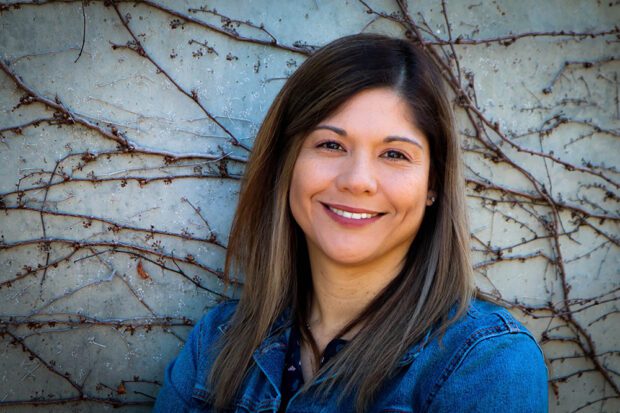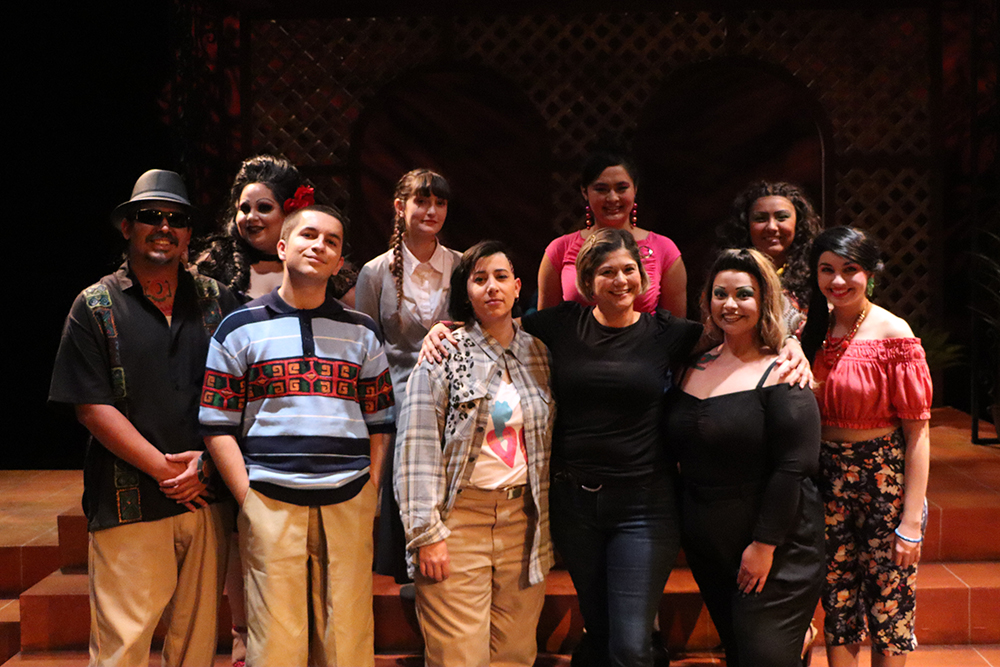
In the depths of the Fresno State theater school, a handful of students from diverse racial and cultural backgrounds bring to life a project with a strong Latin base. This project is the work of Gina Sandi-Díaz, a professor and theater director born in Costa Rica who has considered Fresno her home for seven years.
“My priority is to share a bit of Latin art and culture with the students, but especially with students who have some connection to Latin culture, of Latin descent,” says Sandi-Díaz. “I am interested in proposing plays for the CSU Fresno Theater Program by Latin playwrights in the United States, and by women.
“In other words, I am interested in staging plays written by Latin American women. For example, my next staging will be Los Pecados de Sor Juana by Karen Zacarías, a Mexican playwright living in the U.S.”
In her acting classes, Sandi-Díaz exposes her bilingual students to materials that “resonate” with their culture and history, with characters like them—bilingual, bicultural—reinforcing the commitment of these young people. In this way, Sandi-Díaz assures, the quality and commitment of the interpretation is greater and deeper.
However, the social composition of the student body is varied. “We live in a city where several cultures coexist, and theater classes reflect that diversity,” says Sandi-Díaz. “There are students of Hmong, Punjabi, Mexican, Central American origin…
“You have to work with all of them, motivate them, discover their talents. Some of them are oriented toward dramaturgy, and I support them, and some of them consider me their mentor, and it makes me feel proud.”

Sandi-Díaz highlights the cases of two of her students who have excelled in this area. One of them is currently completing her master’s degree at the University of Austin in dramaturgy and performing arts. Another of her students is currently in New Hampshire with the same purpose.
For this “Tica” (nickname for those born in Costa Rica) director, growing and developing the theater project is fundamental. “We seek to connect with the community, with organizations that work with less visible social groups, or with immigrants, as is the case of Pan Valley Institute. These contacts and spaces that we open allow the project to grow and enrich itself.”
This social openness is important for the Fresno State theater department. But bringing theater to the community is not a simple operation, as the university has precise protocols.
Efforts to attract the community to the university theater have not yielded the expected results. For the general public, visiting the university is not a simple operation, including parking and the distance between the parking lot and the theater.
“There are administrative barriers; we have to be creative to get the public closer to the work we do,” says Sandi-Díaz. “In Costa Rica, that was precisely what we did; we went to present ourselves to the communities, to the neighborhoods. Here there are limits, including logistic ones. I think that culture also influences this status quo.”
This experience is new for this theater director trained in a Latin American country. And what, precisely, is the training and professional experience that Sandi-Díaz brings to Fresno?
When she was a 10th grade student, a language teacher asked her students—among them Sandi-Díaz—to present a scene from the book Don Quixote. This experience was the seed of her interest in theater. Later, she decided to enter theater school. For the audition, she prepared a scene based on a poem she had written herself. She was accepted and thus began her career and training as a theater director and teacher.
Her most influential teachers were Remberto Chávez and his assistant Jorge Hugo Carrillo. Chávez studied theater in Russia at the School of Dramatic Art created by the legendary Konstantin Stanislavski. “[Chávez] was a very strict but very motivating teacher,” says Sandi-Díaz.
Over time, other teachers were instrumental in her training. “I realized that these teachers were all men. Although there were actresses, the directors and those who distributed the knowledge were all men. I never had a female teacher. In the U.S., most of the teachers were men and a few women, white. Not Latinas.”
The patriarchal structure of traditional theater was a motivation for Sandi-Díaz to create a different and more inclusive space. Today, she feels proud to be a Latina teacher and theater director.
Her relationship with the United States was established from a young age. Her mother received a scholarship to obtain her doctorate. Thus, they lived in Chico for three years, which allowed her to learn English and become familiar with the lifestyle of American society.
After graduating from college in Costa Rica, Sandi-Díaz obtained her master’s degree at the University of Kansas. After a period of professional work in her country, she returned to the University of Kansas to obtain her doctorate.
Then, in 2017, she arrived in Fresno to work at the local university. “I wanted to work in a place where there was a strong Latino population,” she says. “I feel very good here.”
Sandi-Díaz’s theatrical style is strongly influenced by different currents of Latin American theater, such as the Theater of the Oppressed, created by the Brazilian Augusto Boal. She worked with the techniques of the Theater of the Oppressed in rural areas of Costa Rica. She also recognizes the influence of Enrique Buenaventura, from the Experimental Theater of Cali, Colombia, “the father of the collective creation.”
Over time, she has incorporated other influences, which contribute to her particular style of directing and teaching theater.
“I think that a female perspective of doing theater is missing. I am currently reflecting a lot on that. I am writing a book on theater direction, on alternative ways of directing theater. For this, I am interviewing many theater people, many of them people of color, and above all, women, but also men who are doing things differently to break a little bit the patriarchal male hierarchy of the way we make theater. All of this motivates me a lot.”

